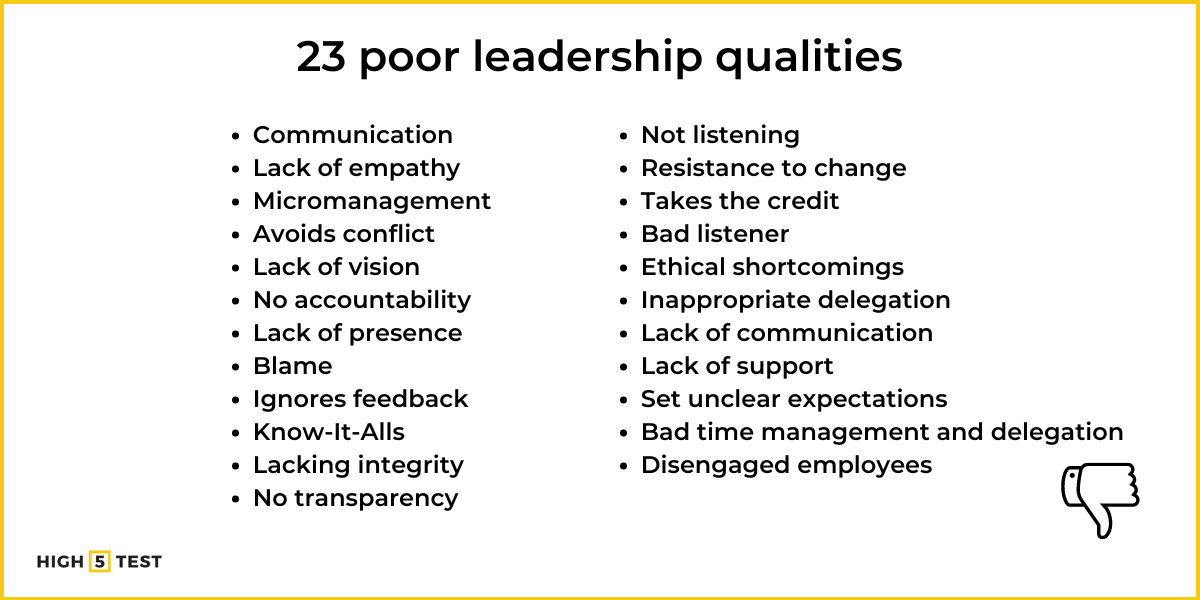Leaders play a pivotal role in shaping our professional lives and personal growth. While they are responsible for delegating tasks and facilitating development within an organization, truly effective leaders go beyond these basic functions. They inspire and empower their teams to unlock their full potential by leveraging individual strengths. The HIGH5 strengths assessment provides a comprehensive understanding of each team member’s unique talents and abilities (including the leaders themselves), enabling leaders to create an environment where everyone can thrive and contribute to collective success.
Unfortunately, not everyone has had the pleasure of being managed by a good leader. Although we might assume that leaders are in their position because they are equipped with appropriate skills and experience, this isn’t always the case, and there are people in management roles with poor leadership qualities. Their lack of capacity and skills can affect all of their subordinates and even the clients, companies, or projects they lead.
Poor leadership impacts a company’s ability to retain employees. It affects the morale, motivation, and productivity of any work team [1]. Knowing the characteristics of a bad leader will help you be resilient to problems at work, but it can also help you identify gaps in your professional mentorship so you can seek additional resources or support to ensure your growth continues. Conversely, if you are a bad leader, you can improve and strengthen your leadership skills through strengths-based leadership [2]. Next, we’ll talk about what bad leadership is and why it can be so detrimental to us personally and professionally. We will also mention a list of leadership qualities that characterize a bad leader and how to deal with them.
What is bad leadership?
Bad leadership is when the leader instead of motivating and driving the workgroup, harms the group or individuals morally, sets inappropriate goals (either with not enough stretch, or is misaligned with the capacity of the team, or they may be self-serving to the leader themselves), demotivates them, and affects their performance when it comes to achieving a strategic goal or professional growth/development [1]. In any work environment, leaders need certain qualities to manage and interact with their employees or team members in meaningful and effective ways. There are many leadership styles, but we will talk about the three defined by psychologist Kurt Lewin [3]. These are authoritarian leadership, democratic leadership, and Laissez-Faire leadership.
- Authoritarian (autocratic) – leaders who follow this style tend to make decisions without input from others, and they expect adherence or compliance with their requests. Although this can help in situations when a quick decision needs to be made, it can be detrimental to the satisfaction, fulfillment, and creativity of team members.
- Democratic (participative) – these leaders involve their team actively in decision-making processes and they value their input. These kinds of leaders tend to have better team engagement and team members feel more satisfied or fulfilled in their role, but it can slow down decision-making.
- Laissez-Fair (delegative) – leaders who use this style give a lot of decision-making freedom to the people they manage, but they don’t give a lot of guidance. This can be empowering for some team members, but can also lead to disorganization or distress if team members need that direction or support.
Although each style has leadership strengths, it also has weaknesses. Of course, this will depend on the characteristics of each leader. The following discussion explains this more comprehensively. Now we have explored some of the outcomes of bad leadership, it’s time to unpack some of the behaviors or warning signs to be on the lookout for. Bad leadership characteristics are often overlooked by the people they manage due to the authoritarian position in which the bad leader is positioned.
23 characteristics and warning signs of a bad leader

- Bad communication
- Lack of empathy
- Micromanagement
- Avoids conflict
- Lack of vision
- No accountability
- Lack of presence
- Blame
- Ignores feedback
- Know-It-Alls
- Lacking integrity
- No transparency
- Not listening
- Resistance to change
- Takes the credit
- Bad listener
- Ethical shortcomings
- Inappropriate delegation
- Lack of communication
- Lack of support
- Set unclear expectations
- Bad time management and delegation
- Disengaged employees
Bad communication
Ineffective or poor communication can lead to misunderstandings and confusion within the team.
Lack of empathy
Failing to understand or relate to team members’ feelings and perspectives.
Micromanagement
Over-controlling team members and not allowing them autonomy or trust.
Avoids conflict
Evades addressing issues, leading to unresolved problems and tension.
Lack of vision
Fails to provide a clear direction or long-term goals for the team.
No accountability
Does not take responsibility for their actions or decisions.
Lack of presence
Not being available or involved with the team when needed.
Blame
Assigns fault to others instead of accepting responsibility for failures.
Ignores feedback
Dismisses or neglects constructive criticism from the team. Or does not take other’s opinions, thoughts or suggestions into account.
Know-it-alls
They believe they have all the answers and disregard others’ input.
Lacking integrity
Shows dishonesty or unethical behavior, eroding trust.
No transparency
Keeps important information from the team, leading to mistrust.
Not listening
Fails to actively listen to team members’ ideas or concerns.
Resistance to change
Unwilling to adapt or consider new approaches and ideas.
Takes the credit
Claims the team’s successes as their own, undermining morale.
Bad listener
Does not pay attention to or value team members’ input.
Ethical shortcomings
Engages in unethical practices that can harm the team, reputation (of individuals and the wider business) and organization.
Inappropriate delegation
Assigns tasks without considering team members’ strengths, skills or workloads.
Lack of communication
Does not effectively convey expectations, key information needed to complete tasks, goals, or feedback.
Lack of support
Does not provide the necessary resources or assistance to the team.
Set unclear expectations
Fails to define clear goals and roles for team members.
Bad time management and delegation
Inefficiently handles tasks and delegates poorly.
Disengaged employees
Creates an environment where team members feel unmotivated and uninvolved.
Tips on how to address the most common poor leadership qualities
If you are a leader yourself you may have identified that these are some areas that you currently struggle with. Or if you have a business, or are being led by someone who demonstrates poor leadership qualities, here’s how to take personal accountability which can go a long way to addressing some of the key issues that arise from poor leadership qualities:
Avoids conflict
Issue: A leader who avoids conflict allows problems to persist and worsen over time.
Solution: Encourage open communication and address issues directly but tactfully. Create a safe space for team members to express concerns and work collaboratively to resolve conflicts.
Lack of accountability
Issue: A leader who does not take responsibility for their actions undermines trust and credibility.
Solution: Lead by example and own up to mistakes. Implement a culture of accountability where everyone, including the leader, is responsible for their actions and outcomes.
Poor communication
Issue: Ineffective communication leads to misunderstandings and a lack of direction.
Solution: Improve communication skills by being clear, concise, and consistent. Hold regular meetings to update the team, provide feedback, and ensure everyone is on the same page. It can help to put things in writing, check for understanding and have clear boundaries, expectations, deadlines etc so that everyone is on the same page.
Lack of empathy
Issue: A leader who lacks empathy fails to connect with their team, leading to a lack of trust and morale.
Solution: Practice active listening and show genuine concern for team members’ well-being. Understand their perspectives and provide support when needed. Show your interest by making eye contact, using non-verbal cues to demonstrate interest (nodding, facing your body towards the person speaking), asking questions relevant to the discussion and summarizing what you have heard. You can also name any emotions you have identified to help demonstrate that you care “I can tell you are really worried about this upcoming deadline”.
Micromanagement
Issue: A leader who resists change can hinder team progress and adaptability.
Solution: Be open to new ideas and foster a culture of innovation. Encourage team members to share suggestions and be willing to adapt strategies as needed.
Resistance to change
Issue: A leader who resists change can hinder team progress and adaptability.
Solution: Be open to new ideas and foster a culture of innovation. Encourage team members to share suggestions and be willing to adapt strategies as needed.
Pro Tip From HIGH5
Instead of focusing solely on your leader’s weaknesses, take a strengths-based approach by identifying and leveraging your own strengths. The HIGH5 assessment can provide valuable insights into your natural abilities, helping you cultivate resilience, maintain a positive mindset, and continue contributing to the team’s success despite the leadership challenges.
Negative effects of poor and bad leadership
Bad leaders impact team performance
Poor leadership can have devastating effects on a team’s morale and productivity. When individuals feel undervalued, ignored, and unmotivated, they are unlikely to put forth their best efforts. This is where the HIGH5 strengths assessment can be invaluable. By identifying and leveraging each team member’s unique strengths, leaders can not only identify their own strengths/challenges but they can create an environment where everyone feels valued and motivated to contribute. When individuals are empowered to leverage their natural talents, they are more likely to be engaged, productive, and committed to achieving collective goals.
The development of each team member suffers from poor leadership
A true leader is a teacher who supports, encourages and develops their teams through motivation, empathy and guidance. A poor leader often accepts success at an individual level and doesn’t share recognition with others in the team. In addition to not sharing recognition, a poor leader may engage in blaming their team rather than themself when something goes wrong. If someone works in a place where they are not motivated to develop their skills or to grow professionally and their efforts are undervalued, they will quickly stagnate.
This is important because, by comparing this situation to one in which strengths-based leadership is employed, the team will be encouraged to explore their strengths and are more likely to grow, feel motivated and be successful in their role. Through positive reinforcement, they feel more confident to work on their weaknesses and don’t avoid challenges but see them as opportunities for growth and development. Setting more challenging goals that would allow them to grow and succeed. A bad leader does not encourage their efforts. Nor do they provide their team with the right tools they need to develop.
The working environment becomes chaotic and unpleasant
Unhappy and dissatisfied employees can make others feel the same way. Even if someone maintains a positive attitude, it is difficult to maintain it in an environment that is surrounded by negativity, or toxic leadership. If the leader does not maintain an environment where motivation, camaraderie, order, and efficiency reign, it’s likely that they need to make improvements in their capacity as a leader.
Resignations and poor outcomes within the work environment increase
Through negative reinforcement, poor leadership will inevitably cause motivation and production quality to decrease. Not only that, but it will cause many team members to give up and quit too. They will go in search of an enriching opportunity that will allow them to grow. The results can be a loss of customers and a breakdown in employee relations and the work environment. As more people express an interest in leaving, others may think the “ship” is sinking. So they will jump overboard too. For all of the above reasons, it is important to have good and committed leaders who are involved with the growth of their team and the organization they represent.
Pro Tip From HIGH5
Leverage the insights from the HIGH5 strengths assessment to foster an environment of appreciation and recognition. Celebrate team members’ unique contributions and provide opportunities for them to utilize their strengths in meaningful ways. This will not only boost morale and engagement but also unlock greater levels of productivity and success.
Poor leadership FAQ
How do you identify a bad leader?
You can typically identify a poor leader by looking at their team and the results they produce as well as the retention rates of employees. If the leader’s team is uninspired, bored, constantly fighting, unproductive, uncommitted, not communicating, and so on, the leader’s weaknesses are allowing these negative aspects to continue. Plus, if the leader’s team produces very tangible outcomes (for example sales, or doesn’t meet key deadlines for projects), or in general does not meet their goals, the leader is likely incompetent.
What are the qualities of a bad leader?
Bad leaders produce bad teams. They do not offer the support and direction that good leaders offer their teams. Some qualities that define bad leadership include ineffective communication (or no communication at all), lack of care, lack of transparency, lack of trust, enlarged ego, poor delegation skills, unwillingness to listen to employees, lacking passion and/or charisma, and so on.
What defines a weak leader?
A weak leader lacks vision, fails to inspire or motivate their team, and avoids making decisions or addressing conflicts.
How do you identify a poor leader?
A poor leader can be identified by their team’s low morale, lack of productivity, and the presence of unresolved conflicts, along with poor communication and accountability.
Conclusion
It is difficult to deal with bad leadership. It is something that affects the company, the customer, the team, and even the leader himself. But despite the consequences, we can overcome these adversities by focusing on personal accountability and modeling appropriate behaviors. We are all leaders the moment we decide to behave in an exemplary manner. Now that you know what poor leadership qualities look like, take the initiative to transform your environment by relying on your strengths. Only then will you be able to deal with these leadership weaknesses successfully.
References:
- Li, P., Yin, K., Shi, J. et al. Are Bad Leaders Indeed Bad for Employees? A Meta-Analysis of Longitudinal Studies Between Destructive Leadership and Employee Outcomes. J Bus Ethics 191, 399–413 (2024). https://doi.org/10.1007/s10551-023-05449-2.
- Chu, X., Ding, H., Zhang, L., & Li, Z. A. (2022). Strengths-Based Leadership and Turnover Intention: The Roles of Felt Obligation for Constructive Change and Job Control. Frontiers in psychology, 13, 786551. https://doi.org/10.3389/fpsyg.2022.786551.
- Burnes, B. (2020). The Origins of Lewin’s Three-Step Model of Change. The Journal of Applied Behavioral Science, 56(1), 32-59. https://doi.org/10.1177/0021886319892685.







![Team Building Activities Definition & Lists [2021] High5](https://high5test.com/wp-content/uploads/2021/10/Team-Building-Activities-Definition-Lists-2021-High5-300x187.jpg)
